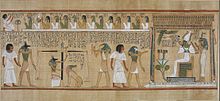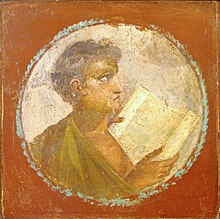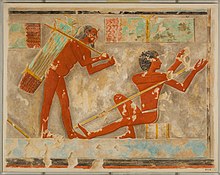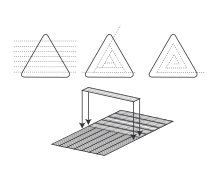Papyrus
Papyrus (, an early form of a book.

Papyrus was first known to have been used in
History

Papyrus was first manufactured in Egypt as far back as the third millennium BCE.

Codices were an improvement on the papyrus scroll, as the papyrus was not pliable enough to fold without cracking, and a long roll, or scroll, was required to create large-volume texts. Papyrus had the advantage of being relatively cheap and easy to produce, but it was fragile and susceptible to both moisture and excessive dryness. Unless the papyrus was of perfect quality, the writing surface was irregular, and the range of media that could be used was also limited.
Papyrus was replaced in Europe by the cheaper, locally produced products
Papyrus was made in several qualities and prices. Pliny the Elder and Isidore of Seville described six variations of papyrus that were sold in the Roman market of the day. These were graded by quality based on how fine, firm, white, and smooth the writing surface was. Grades ranged from the superfine Augustan, which was produced in sheets of 13 digits (10 inches) wide, to the least expensive and most coarse, measuring six digits (four inches) wide. Materials deemed unusable for writing or less than six digits were considered commercial quality and were pasted edge to edge to be used only for wrapping.[12]
Until the middle of the 19th century, only some isolated documents written on papyrus were known, and museums simply showed them as curiosities.
Etymology
The
In the Egyptian language, papyrus was called wadj (w3ḏ), tjufy (ṯwfy), or djet (ḏt).
Documents written on papyrus

The word for the material papyrus is also used to designate documents written on sheets of it, often rolled up into scrolls. The plural for such documents is papyri. Historical papyri are given identifying names – generally the name of the discoverer, first owner, or institution where they are kept – and numbered, such as "
Manufacture and use




Papyrus is made from the stem of the papyrus plant, Cyperus papyrus. The outer rind is first removed, and the sticky fibrous inner pith is cut lengthwise into thin strips about 40 cm (16 in) long. The strips are then placed side by side on a hard surface with their edges slightly overlapping, and then another layer of strips is laid on top at right angles. The strips may have been soaked in water long enough for decomposition to begin, perhaps increasing adhesion, but this is not certain. The two layers possibly were glued together.[20] While still moist, the two layers are hammered together, mashing the layers into a single sheet. The sheet is then dried under pressure. After drying, the sheet is polished with a rounded object, possibly a stone, seashell, or round hardwood.[21]
Sheets, or Mollema, could be cut to fit the obligatory size or glued together to create a longer roll. The point where the Mollema are joined with glue is called the kollesis. A wooden stick would be attached to the last sheet in a roll, making it easier to handle.
In a dry
Sporadic attempts to revive the manufacture of papyrus have been made since the mid-18th century.
Papyrus is still used by communities living in the vicinity of swamps, to the extent that rural householders derive up to 75% of their income from swamp goods.[26] Particularly in East and Central Africa, people harvest papyrus, which is used to manufacture items that are sold or used locally. Examples include baskets, hats, fish traps, trays or winnowing mats, and floor mats.[27] Papyrus is also used to make roofs, ceilings, rope, and fences. Although alternatives, such as eucalyptus, are increasingly available, papyrus is still used as fuel.[26]
Collections of papyrus

- the Morgan Library & Museum(New York).
- Archduke Rainer Collection, also known as the Vienna Papyrus Collection: is one of the world's largest collections of papyri (about 180,000 objects) in the Austrian National Library of Vienna.[28]
- Berlin Papyri: housed in the Egyptian Museum and Papyrus Collection.[29]
- Berliner Griechische Urkunden (BGU): a publishing project ongoing since 1895
- Copticdocuments, classical texts, biblical books, and writing of the early churches.
- Chester Beatty Papyri: a collection of 11 codices acquired by Alfred Chester Beatty in 1930–1931 and 1935. It is housed at the Chester Beatty Library. The collection was edited by Frederic G. Kenyon.
- Colt Papyri, housed at the Morgan Library & Museum(New York).
- The Naples National Archaeological Museum.[30]
- The Heroninos Archive: a collection of around a thousand papyrus documents, dealing with the management of a large Roman estate, dating to the third century CE, found at the very end of the 19th century at Kasr El Harit, the site of ancient Theadelphia, in the Faiyum area of Egypt by Bernard Pyne Grenfell and Arthur Surridge Hunt. It is spread over many collections throughout the world.
- The Houghton's papyri: the collection at Egypt Exploration Fund.[31]
- Martin Schøyen Collection: biblical manuscripts in Greek and Coptic, Dead Sea Scrolls, classical documents
- Michigan Papyrus Collection: this collection contains above 10,000 papyri fragments. It is housed at the University of Michigan.
- Oxyrhynchus Papyri: these numerous papyri fragments were discovered by Grenfell and Hunt in and around Oxyrhynchus. The publication of these papyri is still in progress. A large part of the Oxyrhynchus papyri are housed at the Ashmolean Museum in Oxford, others in the British Museum in London, in the Egyptian Museum in Cairo, and many other places.
- Princeton Papyri: it is housed at the Princeton University[32]
- Papiri della Società Italiana (PSI): a series, still in progress, published by the Società per la ricerca dei Papiri greci e latini in Egitto and from 1927 onwards by the succeeding Istituto Papirologico "G. Vitelli" in Biblioteca Laurenziana.
- John Rylands University Library.
- Tebtunis Papyri: housed by the Bancroft Library at the University of California, Berkeley, this is a collection of more than 30,000 fragments dating from the 3rd century BCE through the 3rd century CE, found in the winter 1899–1900 at the site of ancient Tebtunis, Egypt, by an expedition team led by the British papyrologists Bernard P. Grenfell and Arthur S. Hunt.[33]
- Washington University Papyri Collection: includes 445 manuscript fragments, dating from the first century BCE to the eighth century AD. Housed at the Washington University Libraries.
- Yale Papyrus Collection: housed by the Beinecke Library, it contains over six thousand inventoried items. It is cataloged, digitally scanned, and accessible online.[34]
Individual papyri
- Brooklyn Papyrus: this papyrus focuses mainly on snakebites and their remedies. It speaks of remedial methods for poisons obtained from snakes, scorpions, and tarantulas. The Brooklyn Papyrus currently resides in the Brooklyn Museum.[35]
- Saite Oracle Papyrus: this papyrus located at the Brooklyn Museum records the petition of a man named Pemou on behalf of his father, Harsiese to ask their god for permission to change temples.
- Strasbourg papyrus
- 20th dynasty, it is notable because it is a legal document for a non-noble woman.[36]
See also
- Other ancient writing materials:
- Palm leaf manuscript(India)
- Amate (Mesoamerica)
- Paper
- Ostracon
- Wax tablets
- Clay tablets
- Birch bark document
- Parchment
- Pliny the Elder
- Papyrology
- Papyrus sanitary pad
- Palimpsest
- For Egyptian papyri:
- List of ancient Egyptian papyri
- Other papyri:
- Elephantine papyri
- Magdalen papyrus
- Nag Hammadi library
- New Testament papyri
- The papyrus plant in Egyptian art
References
Citations
- ^ "Papyrus definition". Dictionary.com. Retrieved 20 November 2008.
- ^ "Papyrus". Merriam-Webster.com. Retrieved 27 March 2023.
- ^ "Ebers Papyrus". Encyclopædia Britannica. Retrieved 8 March 2014.
- ^ Houston, Keith, The Book: A Cover-to-Cover Exploration of the Most Powerful Object of our Time, W. W. Norton & Company, 2016, pp. 4–8 excerpt [1]
- ^ ISSN 2049-5021. Retrieved 21 April 2013.
- ^ a b H. Idris Bell and T.C. Skeat, 1935. "Papyrus and its uses" (British Museum pamphlet). Archived 18 October 2013 at the Wayback Machine
- ^ Stille, Alexander. "The World's Oldest Papyrus and What It Can Tell Us About the Great Pyramids". Retrieved 27 September 2015.
- ^ Černý, Jaroslav. 1952. Paper and Books in Ancient Egypt: An Inaugural Lecture Delivered at University College London, 29 May 1947. London: H. K. Lewis & Co. Ltd. (Reprinted Chicago: Ares Publishers Inc., 1977).
- ^ Pirenne, Mohammed and Charlemagne, critiqued by R.S. Lopez, "Mohammed and Charlemagne: a revision", Speculum (1943:14–38.).
- ^ David Diringer, The Book before Printing: Ancient, Medieval and Oriental, Dover Publications, New York 1982, p. 166.
- ISBN 0-88402-248-X.
- ^ Lewis, N (1983). "Papyrus and Ancient Writing: The First Hundred Years of Papyrology". Archaeology. 36 (4): 31–37.
- ^ a b Hans Dieter Betz (1992). The Greek Magical Papyri in Translation, Including the Demotic Spells, Volume 1. University of Chicago Press.
- ^ Frederic G. Kenyon, Palaeography of Greek papyri (Oxford, Clarendon Press, 1899), p. 1.
- ^ Frederic G. Kenyon, Palaeography of Greek papyri (Oxford, Clarendon Press, 1899), p. 3.
- ISBN 0-486-24243-9.
- ^ πάπυρος, Henry George Liddell, Robert Scott, A Greek-English Lexicon, on Perseus
- ISBN 9789004174191.
- ^ βύβλος, Henry George Liddell, Robert Scott, A Greek-English Lexicon, on Perseus
- ^ Introduction to Greek and Latin Palaeography, Maunde Thompson. archive. org
- ^ Bierbrier, Morris Leonard, ed. 1986. Papyrus: Structure and Usage. British Museum Occasional Papers 60, ser. ed. Anne Marriott. London: British Museum Press.
- ISBN 978-1-60606-083-4.
- ISBN 9781602397064.
- ^ Cerny, Jaroslav (1947). Paper and books in Ancient Egypt. London: H. K. Lewis & Co. Ltd.
- ^ Lucas, A. (1934). Ancient Egyptian Materials and Industries, 2nd Ed. London: Edward Arnold and Co.
- ^ a b Maclean, I.M.D., R. Tinch, M. Hassall, and R.R. Boar. 2003c. "Towards optimal use of tropical wetlands: an economic evaluation of goods derived from papyrus swamps in southwest Uganda." Environmental Change and Management Working Paper No. 2003-10, Centre for Social and Economic Research into the Global Environment, University of East Anglia, Norwich.
- ^ Langdon, S. 2000. Papyrus and its Uses in Modern Day Russia, Vol. 1, pp. 56–59.
- ^ "Department for Papyri". Osterreichische Nationalbibliothek.
- ^ "Ägyptisches Museum und Papyrussammlung". Staatliche Museen zu Berlin.
- ISBN 0-486-24243-9.
- ^ "Digital Papyri at Houghton Library, Harvard University". Archived from the original on 3 April 2012. Retrieved 30 July 2011.
- ^ "Digital Images of Selected Princeton Papyri". Archived from the original on 1 December 2008. Retrieved 13 December 2008.
- ^ "The Center for the Tebtunis Papyri".
- ^ "The Yale Papyrus Collection". Beinecke Rare Book & Manuscript Library. 14 December 2018. Retrieved 17 September 2023.
- ^ "Ancient Egyptian Medical Papyri". Retrieved 17 June 2014.
- JSTOR 3855381.
Sources
- Leach, Bridget, and William John Tait. 2000. "Papyrus". In Ancient Egyptian Materials and Technology, edited by Paul T. Nicholson and Ian Shaw. Cambridge: Cambridge University Press. 227–253. Thorough technical discussion with extensive bibliography.
- Leach, Bridget, and William John Tait. 2001. "Papyrus". In The Oxford Encyclopedia of Ancient Egypt, edited by Donald Bruce Redford. Vol. 3 of 3 vols. Oxford, New York, and Cairo: Oxford University Press and The American University in Cairo Press. 22–24.
- Parkinson, Richard Bruce, and Stephen G. J. Quirke. 1995. Papyrus. Egyptian Bookshelf. London: British Museum Press. General overview for a popular reading audience.
Further reading
- Horst Blanck: Das Buch in der Antike. Beck, München 1992, ISBN 3-406-36686-4
- Rosemarie Drenkhahn: Papyrus. In: Wolfgang Helck, Wolfhart Westendorf (eds.): Lexikon der Ägyptologie. vol. IV, Wiesbaden 1982, Spalte 667–670
- David Diringer, The Book before Printing: Ancient, Medieval and Oriental, Dover Publications, New York 1982, pp. 113–169, ISBN 0-486-24243-9.
- Victor Martin (Hrsg.): Ménandre. Le Dyscolos. Bibliotheca Bodmeriana, Cologny – Genève 1958
- Otto Mazal: Griechisch-römische Antike. ISBN 3-201-01716-7(Geschichte der Buchkultur; vol. 1)
External links
- Leuven Homepage of Papyrus Collections
- Ancient Egyptian Papyrus – Aldokkan
- Yale Papyrus Collection Database at the Beinecke Rare Book and Manuscript Library at Yale University
- Lund University Library Papyrus Collection
- Ghent University Library Papyrus Collection
- Thompson, Edward Maunde (1911). . Encyclopædia Britannica. Vol. 20 (11th ed.). pp. 743–745.
- "Papyri.info Resource and Partner Organizations". papyri.info. Archived from the original on 26 October 2018. Retrieved 26 October 2018.
- Finding aid to the Advanced Papyrological Information System records at Columbia University. Rare Book & Manuscript Library.
- Modern commercial Papyrus paper making (photos)– Elbardy
- Papyrus-making in Egypt (video), scidevnet, via youtube, April 2019.
